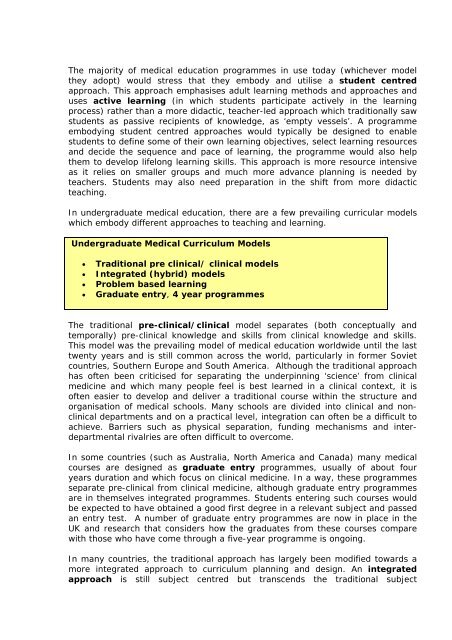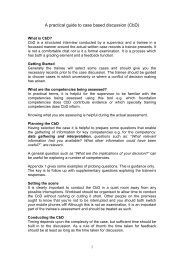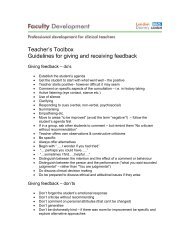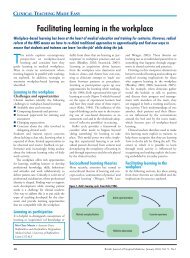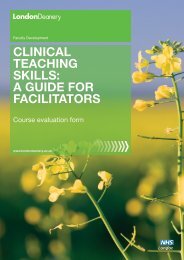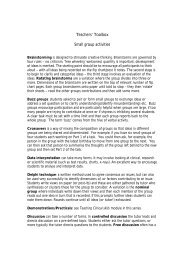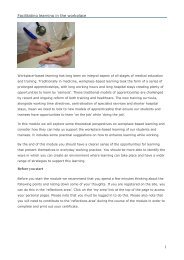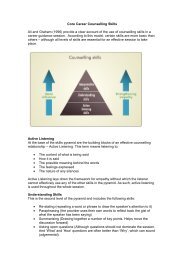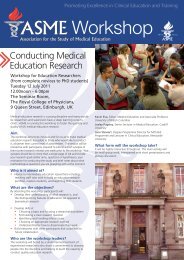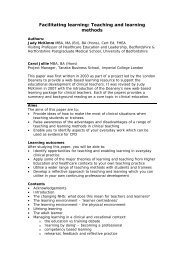Curriculum development module - Faculty Development - London ...
Curriculum development module - Faculty Development - London ...
Curriculum development module - Faculty Development - London ...
Create successful ePaper yourself
Turn your PDF publications into a flip-book with our unique Google optimized e-Paper software.
The majority of medical education programmes in use today (whichever model<br />
they adopt) would stress that they embody and utilise a student centred<br />
approach. This approach emphasises adult learning methods and approaches and<br />
uses active learning (in which students participate actively in the learning<br />
process) rather than a more didactic, teacher-led approach which traditionally saw<br />
students as passive recipients of knowledge, as ‘empty vessels’. A programme<br />
embodying student centred approaches would typically be designed to enable<br />
students to define some of their own learning objectives, select learning resources<br />
and decide the sequence and pace of learning, the programme would also help<br />
them to develop lifelong learning skills. This approach is more resource intensive<br />
as it relies on smaller groups and much more advance planning is needed by<br />
teachers. Students may also need preparation in the shift from more didactic<br />
teaching.<br />
In undergraduate medical education, there are a few prevailing curricular models<br />
which embody different approaches to teaching and learning.<br />
Undergraduate Medical <strong>Curriculum</strong> Models<br />
• Traditional pre clinical/ clinical models<br />
• Integrated (hybrid) models<br />
• Problem based learning<br />
• Graduate entry, 4 year programmes<br />
The traditional pre-clinical/clinical model separates (both conceptually and<br />
temporally) pre-clinical knowledge and skills from clinical knowledge and skills.<br />
This model was the prevailing model of medical education worldwide until the last<br />
twenty years and is still common across the world, particularly in former Soviet<br />
countries, Southern Europe and South America. Although the traditional approach<br />
has often been criticised for separating the underpinning ‘science’ from clinical<br />
medicine and which many people feel is best learned in a clinical context, it is<br />
often easier to develop and deliver a traditional course within the structure and<br />
organisation of medical schools. Many schools are divided into clinical and nonclinical<br />
departments and on a practical level, integration can often be a difficult to<br />
achieve. Barriers such as physical separation, funding mechanisms and interdepartmental<br />
rivalries are often difficult to overcome.<br />
In some countries (such as Australia, North America and Canada) many medical<br />
courses are designed as graduate entry programmes, usually of about four<br />
years duration and which focus on clinical medicine. In a way, these programmes<br />
separate pre-clinical from clinical medicine, although graduate entry programmes<br />
are in themselves integrated programmes. Students entering such courses would<br />
be expected to have obtained a good first degree in a relevant subject and passed<br />
an entry test. A number of graduate entry programmes are now in place in the<br />
UK and research that considers how the graduates from these courses compare<br />
with those who have come through a five-year programme is ongoing.<br />
In many countries, the traditional approach has largely been modified towards a<br />
more integrated approach to curriculum planning and design. An integrated<br />
approach is still subject centred but transcends the traditional subject


